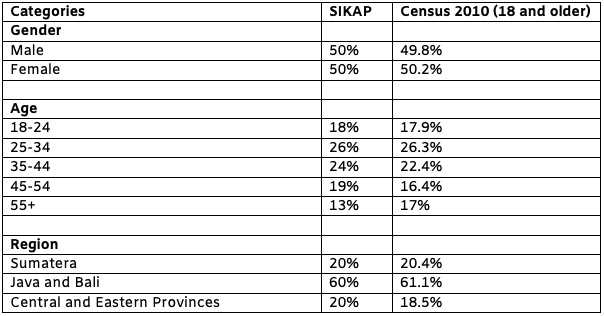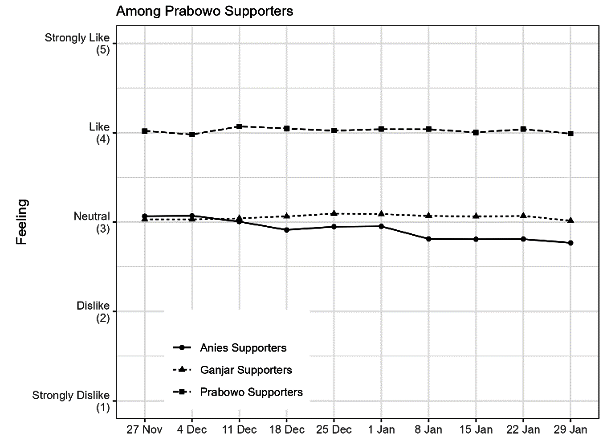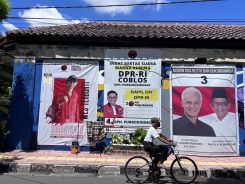“Data! Data! Data! ― I can’t make bricks without clay,” Sherlock Holmes was described saying in Sir Arthur Conan Doyle’s The Adventure of the Copper Beeches.
For students of Indonesian politics, public opinion data is the clay we need to make sense of this year’s national and local elections. The stakes are high: over the past few years, Indonesia has experienced what many observers regard as a democratic erosion.
Consider the recent Constitutional Court ruling that paved the way for Gibran Rakabuming’s inclusion on the ballot as a vice presidential candidate. Was this episode a simple case of elite politics and manoeuvring on the part of Jokowi? Or does it reflect a declining public appetite for the burdens associated with the rule of law?
To answer these sorts of pressing questions, we need access to publicly available survey data. To be sure, there exist several such sources, including the World Values Surveys (WVS), the Asia Barometer survey, the USAID Demographic and Health Surveys, the Indonesian Family Life Survey (IFLS), and the Pew Center’s study of the World’s Muslims, to list some notable examples. But these surveys tend to be one-off snapshots—a fact that undermines their utility for observing how Indonesians’ attitudes are unfolding in real time and in response to external events. (The World Values Survey was most recently conducted in Indonesia in 2018, for example.)
With an eye towards encouraging data-driven research, since November 2023 we have been conducting weekly public opinion surveys, gauging the attitudes of 1,650 Indonesian adults each week. We will continue to conduct weekly surveys until January 2025, aiming to survey approximately 95,000 Indonesian adults over the course of 58 weeks.
Importantly, we will make the data freely available to interested researchers. We call this initiative High-Frequency Surveys on Indonesians’ Knowledge of and Attitudes on Politics (HI-RES SIKAP). Below, we describe the survey design, the sample, two use case examples, and how to access the data.
The design
The SIKAP project draws inspirations from the Nationscape study run by the Democracy Fund and UCLA. As co-Principal Investigators, we contribute equally to the project and would like to acknowledge funding from the Singapore’s Ministry of Education and the National University of Singapore that has made the project possible.
The key component of SIKAP is the weekly online surveys that we have been running and will continue to run for a total of 58 weeks, from 27 November 2023 to 5 January 2025. This period, as students of Indonesia will immediately notice, covers several politically significant events, such as the presidential election in February 2024, the inauguration of Prabowo Subianto as president in October 2024, and the simultaneous local elections in November 2024.
We developed a set of core modules that are asked across all 58 surveys. That the surveys have overlapping core questions, and are fielded weekly means that SIKAP offers insights on how voters’ attitudes on an issue may change as a response to a political event.
For instance, we can theoretically examine if there is a growing sense of affective polarisation over the course of the election campaign. It might be the case, for instance, that supporters of presidential candidates increasingly become more negative toward each other.
Table 1: Core Modules in SIKAP

Sampling methods
Each SIKAP wave collects data from a fresh sample of 1,650 respondents, provided by the online panel vendor Cint (formerly known as Lucid). In the ideal case, by the conclusion of the project we will have collected data from 95,700 unique respondents. However, for several practical reasons, we allow respondents to be interviewed again after eight weeks have passed since their last interviews.
This gives us the best features of cross-sectional and longitudinal data. Aiming for a fresh sample in each wave enables us to capture a diverse pool of respondents. Allowing for multiple interviews, meanwhile, enables us to track how social and political attitudes of re-interviewed respondents might change over the course of 58 weeks.
Online surveys are not representative of the Indonesian population. Many voters do not have internet access and the underlying factors that drive such access may be correlated with the attitudes in which we are interested in measuring. For example, our sample is more educated than the population.
Nevertheless, we prioritised implementing quotas that enabled us to achieve representational parity on other crucial variables: gender, age, and region. These quotas improve the representativeness of our sample and, at the same time, still ensure that each survey wave can finish in one week.
Table 2: Demographic Quotas in SIKAP

The lack of representativeness of our sample has significant implications. Researchers who wish to use our data are solely responsible for the content of their analyses, but in general we would discourage using the SIKAP data to present simple descriptive statistics or to extrapolate those statistics to the population.
For example, it is not advisable for researchers to analyse our presidential vote preference question and then extrapolate that to argue for how many voters support Anies Baswedan, Prabowo Subianto, or Ganjar Pranowo. That kind of exercises requires a different type of sampling method.
Instead, we believe our data is particularly useful for two types of exercises.
The first is to examine the trend of a political attitude as a function of time. For example, a researcher might examine how, as the election date nears, heated religious rhetoric might lead to more exclusionary attitudes among voters.
A new survey shows support for a class and gender mix that better reflects society.
Indonesians want a more diverse legislature
These are just few examples and, in the end, different researchers would want to analyse the data differently. Below, we present two preliminary analyses that we have done on the data.
Use case: affective polarisation
How do supporters of a presidential candidate feel toward supporters of other presidential candidates, and how do these feelings change over the course of the election? This is one of the questions that we can examine using the SIKAP data.
SIKAP includes questions about respondents’ presidential vote preferences. It also includes questions that tap into the respondents’ feelings toward supporters of the three presidential candidates that competed in the February 2024 presidential elections. Respondents may indicate their feelings toward supporters of each of the candidates on a 5-point scale that ranges from a strong dislike to a strong like.
Figure 1 presents levels of affective polarisation among the three candidates’ supporters from the first week of SIKAP (27 November 2023–3 January 2024) to the tenth week (29 January 2024–4 February 2024).
Figure 1: Feelings between supporters of presidential candidates



There are at least two notable patterns.
First, each candidate’s supporters feel most favourable toward fellow supporters. This is rather unsurprising. What is interesting, however, is that the feeling is not extreme―on average, a score of 4 out of possible 5. This suggests that political campaigns do not necessarily induce partisans to become more positive or feel more favourable toward their ingroup.
Second, among both supporters of Prabowo Subianto and Anies Baswedan, feelings toward supporters of Ganjar Pranowo are relatively constant in the ten weeks of the campaign period. They hover around the neutral point of 3. In other words, Anies and Prabowo supporters neither like nor dislike Ganjar supporters.
To the contrary, we observe that Prabowo supporters’ feelings toward Anies supporters increasingly become more negative, which is reciprocated by Anies supporters as their feelings toward Prabowo supporters also became more negative in these 10 weeks. This pattern is more interesting among Anies supporters.
Initially, Anies supporters viewed Prabowo supporters more positively than they did Ganjar supporters. Over time, this perception changed such that by early February Anies supporters actually view Ganjar supporters more favourably than Prabowo supporters. This pattern might actually reflect how in the final days of the campaign Anies’s campaign mounted an offensive against Prabowo, highlighting for example his business deals, land ownership, and lukewarm track record as defence minister.
Use case: gender and generational politics in Indonesia
Considerable attention has been given to the role of the youth vote in Indonesia’s upcoming presidential election. For the first time, a majority of voters will be millennials or gen-Z. This is having wide-ranging consequences for how candidates are appealing to voters, and is widely believed to have influenced Prabowo’s rebranding strategy as a “cuddly grandpa.” To what extent is this pivot working to sway young voters?
Figure 2: Support for Prabowo by generation

SIKAP data allows us to examine this question in-depth. In Figure 3, we examine the share of voters from different generations that support Prabowo. The first takeaway that stands out is that Gen-Z voters are much more likely to support Prabowo than older voters—by a margin of about 20 percentage points. This is surprising in its own right: compared to older voters, young voters are not generally thought to support candidates with authoritarian inclinations. The evidence suggests this may be changing.
Digging deeper, we can examine how generational differences interact with gender in terms of support for Prabowo. Again, what we observe on the right-hand panel of Figure 3 is that older men and women are equally as likely to support Prabowo—there are no gender differences. But the left-hand panel shows a stark gender divide: young men are much more likely to support Prabowo than young women.
The advantage of the high-frequency nature of the SIKAP data is that we can pinpoint the moment at which this gender gap emerges: until the first week of January, young men and women were equally as likely to support Prabowo. But early in the new year, support for Prabowo among young women dropped and support among young men increased—perhaps as a consequence of the 7 January televised presidential debate.
How to access
We welcome researchers, journalists, and other members of the public to access and analyse our data for their research. Our data is unique in its high-frequency nature and as such offers insights difficult to obtain by analysing other datasets. At the same time, we want to make a disclaimer that we are not responsible for inferences drawn by other researchers using our data.
Interested researchers may access the data from our websites nicholaskuipers.com or nathanael.id. For accountability purposes we would like to understand who accesses our data, so prospective users need to fill in a short form and enter their emails. The link to download the data will then be sent to this email.
As the first batch, we are releasing Wave 1 to Wave 11. We will release more waves as the data become available. We are hoping that this simple exercise will help create a path toward greater data sharing and data openness practices in Indonesia.
The post Introducing the HI-RES SIKAP of Indonesian voters appeared first on New Mandala.
This post was originally published on New Mandala.
